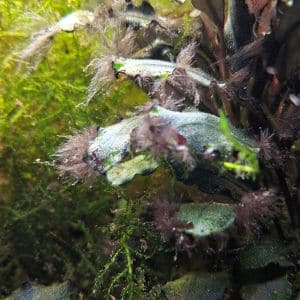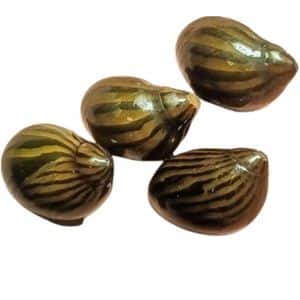Black Beard Algae And How To Get Rid Of It
2 min read

Black Beard Algae, or BBA has long been one of the meanest plagues for fish keepers. This stubborn algae will attach itself to plants, decorations, rocks, and even equipment, making it a persistent problem as it is near impossible to remove manually.
What Is Black Beard Algae? #
Black beard algae is a type of red algae belonging to the genus Audouinella. Despite being classified as “red” algae, BBA typically manifests as dark green, grey, or black tufts that resemble a scruffy beard or brush.
Why Does Black Beard Algae Appear? #
Several factors contribute to the growth of black beard algae in aquariums. Understanding these causes is crucial to both treatment and prevention. The most common triggers include:
- Unstable CO2 Levels: Fluctuating or insufficient carbon dioxide concentrations can stress aquarium plants, providing an opportunity for BBA to take hold.
- Excess Nutrients: High levels of organic waste, particularly phosphates and nitrates, can fuel algae growth.
- Poor Water Circulation: Areas with little water movement are more susceptible to algae build-up.
- Lighting Issues: Too much light or inconsistent lighting schedules can encourage BBA proliferation.
- Overfeeding: Uneaten food decomposes and increases nutrient levels in the water, promoting algae growth.
How to Identify BBA #
Black beard algae is easily recognised by its appearance:
- Dark tufts or patches that can range from deep green to black.
- Feathery or bushy texture, often seen on the edges of plant leaves, driftwood, rocks, and tank equipment.
- It may feel slippery or slimy to the touch and is difficult to remove by hand.
Effective Methods to Get Rid of BBA #
Combating black beard algae requires a combination of physical removal, adjustments to tank conditions, and sometimes the introduction of algae-eating species. Here are proven strategies:
1. Manual Removal
Trim affected plant leaves and remove heavily infested decorations from the tank for thorough cleaning.
Scrub rocks and hard surfaces with an old toothbrush under running water. Avoid using soaps or chemicals.


2. Improve CO2 Stability
If not using a CO2 system, ensure proper water agitation and consider liquid carbon supplements, using as directed.
Increase and stabilise CO2 injection if your aquarium is equipped for it. Consistent CO2 helps plants outcompete algae.
3. Optimise Lighting
The quality of your lights can affect algae growth. Better lights tend to be full spectrum and often come with apps that help you schedule lighting times
Reduce the photoperiod (the amount of time your aquarium lights are on) to 6–8 hours per day.
Avoid placing your tank in direct sunlight or exposing it to excessive ambient light.


4. Control Nutrient Levels
Test water regularly for nitrates and phosphates, and adjust feeding and maintenance accordingly. These nutrients contribute a great deal to the growth of BBA.
Perform regular water changes (at least 30% weekly) to reduce excess nutrients.
Avoid overfeeding fish and promptly remove uneaten food.
5. Introduce Algae-Eating Species
Be mindful to choose species compatible with your tank’s inhabitants and environment.
Certain fish and invertebrates can help control BBA, such as Siamese algae eaters (Crossocheilus oblongus), Amano shrimp, and some snail species.


6. Spot Treatments
Repeat as needed, but do not exceed recommended dosages to avoid harming your plants or livestock.
For persistent patches of BBA, direct application of liquid carbon products (e.g., EasyCarbo, Seachem Excel) using a syringe can be effective. Turn off filtration briefly, apply directly to the algae, and wait a few minutes before resuming normal operation.
Preventing BBA #
Once you have cleared BBA, ongoing prevention is essential:
- Maintain stable CO2 and nutrient levels.
- Keep up with regular water changes and tank maintenance.
- Monitor lighting schedules and avoid overexposing your tank to artificial or natural light.
- Quarantine new plants, rocks, and decorations before adding them to your main aquarium to avoid introducing algae spores.
Conclusion #
Black beard algae can be a stubborn problem in any aquarium, but with a combination of manual removal, improved tank conditions, and the right algae-eating helpers, it can be effectively controlled and prevented. Consistency in maintenance and monitoring is key. With patience and the correct approach, your aquarium can remain a beautiful and healthy environment for both plants and fish.






